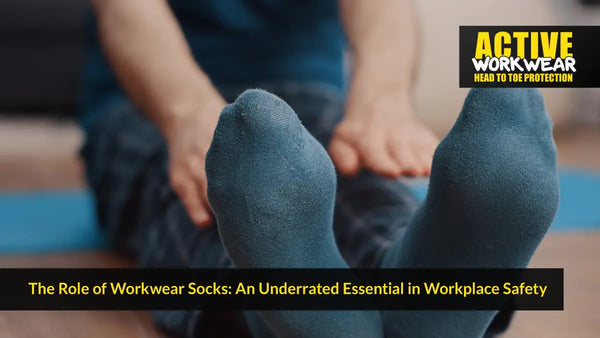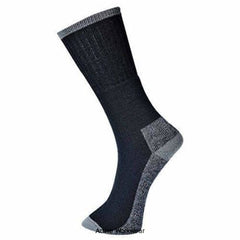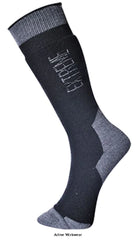The Role of Workwear Socks: An Underrated Essential in Workplace Safety
- by Mike Johnson

Workwear socks, though often overlooked, play a critical role in providing comfort, health, and safety in the workplace. The following article delves into their importance, features to consider when purchasing, and the different materials used in their production.
Workwear socks are specifically designed to offer protection and comfort during long working hours, particularly for those who spend a significant amount of time standing or walking. They are a crucial part of workplace safety and should not be underestimated.
The Importance of Workwear Socks
Primarily, workwear socks offer protection against injuries and discomfort caused by the continuous rubbing of the feet against the interior of work boots or shoes. They help prevent conditions like blisters, corns, and calluses, which can be painful and can affect productivity at work.
Furthermore, workwear socks contribute to maintaining good foot health by reducing foot odour, fungi, and bacteria. This is particularly beneficial for working in wet conditions, as these socks have high moisture-wicking properties, reducing the likelihood of fungal or bacterial infections.
The Role of Workwear Socks in Comfort and Warmth
Apart from protection, workwear socks also enhance comfort and warmth. They provide an additional layer of cushioning, particularly in the arch and heel areas, ensuring comfort during long periods of standing or walking.
During cold winters, specific work socks, such as wool ones, offer extra warmth. They trap heat for insulation, making them essential for outdoor workers or those working in cold environments.
Key Features to Consider in Workwear Socks
When purchasing workwear socks, several factors should be considered to ensure they serve their purpose effectively. These include:
- Fabric: The sock's material impacts its comfort, durability, and suitability for different weather conditions. Common materials used for work socks include cotton, bamboo, wool, and polyester.
- Length: The sock length should match the type of work boot or shoe worn. It also depends on individual preference and the weather.
- Fit: Work socks should fit well to prevent sliding down or bunching up, which could cause discomfort or blisters.
- Cushioning: Extra cushioning provides added comfort, especially for those who stand or walk for long hours.
- Thickness: The thickness of the sock is crucial for comfort and protection. Thick socks offer better cushioning and are more suitable for heavy-duty work boots.
Understanding the Construction of Workwear Socks
Work socks comprise several parts, each serving a specific function.
- Cuff/Welt: This is the top or opening of the sock. It secures the sock over the leg, preventing it from rolling down.
- Leg/Ankle: This part covers the ankle and most of the leg. It is often the most visible part of the sock above the work boots or shoes.
- Instep: The instep is at the top of the foot. It is usually tighter than the cuff and leg areas to ensure a snug fit.
- Heel: The heel section of the sock provides a space for the foot's heel. It often features thicker material for added comfort and to resist wear.
- Foot: This part of the sock covers most of the foot. Some work socks feature reinforced foot sections for better comfort and support.
- Sole: The sole sits at the bottom of the foot. It may have extra cushioning for added comfort and protection.
- Toe: This is the section at the tip of the sock that covers the toes.
The Best Helly Hansen and Portwest Workwear Socks
PORTWEST WORK SOCKS - TRIPLE PACK - SK33
Portwest Work Socks - Pack of Three - SK33
This set includes three pairs of hard-wearing work socks that are a great deal. They feature cushioned soles for added comfort and have a strengthened heel and toe area for extended durability.
The sole is padded for additional comfort.
The areas around the heel and toe are made stronger for increased durability.
COMPOSITION
These socks are made of 79% Acrylic, 15% Nylon, and 6% Polyester.
EXTREME COLD WEATHER WORK SOCKS PORTWEST SK18
Portwest SK18 Extreme Cold Weather Work Socks
These socks have two layers, with the outer layer made mostly from wool. The inner layer helps to control odours and fungal growth while also providing insulation and moisture removal.
KEY FEATURES:
Made from a polyolefin insulating material
Helps reduce smell and combats fungi
Excellent at absorbing and removing moisture
Socks are 40cm in height
Certified by CE
Comes with a retail tag for easy display in stores
COMPOSITION
These socks are made from 40% Wool, 40% Acrylic, and 20% Nylon.
Final Thoughts
Workwear socks are an underrated yet essential component of workplace safety. Therefore, it is crucial to invest in high-quality socks that offer protection, comfort, and durability. By understanding their importance and knowing what to look for, individuals can ensure they make the right choice when purchasing workwear socks.
Remember, the primary consideration should not be the price but the quality and features of the socks. After all, in the context of workplace safety and comfort, the role of workwear socks is invaluable.
Frequently Asked Questions
Here are some frequently asked questions about workwear socks.
What are work socks?
Work socks are unique socks made to be used in demanding jobs, especially in hard labour jobs or work done outdoors. They are usually thicker and sturdier than regular socks and often have stronger heels and toes for more protection. Some versions also come with special features like the ability to pull moisture away or provide warmth to deal with various weather conditions.
What socks to wear in work boots?
For work boots, it's best to choose socks that:
1. They use materials that draw moisture away to keep your feet dry. Materials like synthetic polyester or natural merino wool are good choices as they handle sweat effectively.
2. Have a good amount of cushioning, particularly in the heel and toe areas. This provides extra comfort during long hours of standing or walking.
3. Are tall enough to reach over your work boots to prevent chafing.
4. Are thermal or insulating if you're working in cold conditions.
5. Have a snug but not tight fit to prevent blisters. If too loose, your socks may bunch up inside the shoe, creating discomfort.
Always remember that the right socks can provide another layer of protection and comfort.
What material is best for work socks?
The best material for work socks depends on your specific needs, weather conditions and how much you sweat. Here are some materials commonly used for work socks:
1. Merino Wool: These socks are known for their exceptional breathability and moisture-wicking capabilities. They also have excellent temperature regulation, making them suitable for warm and cold conditions.
2. Coolmax: This is a polyester blend designed for moisture management. It's lightweight and breathable, perfect for warmer weather or indoor work.
3. Nylon: This has excellent durability and strength. It may not be as breathable as other options, but it's often blended with other materials for increased comfort.
4. Cotton: This is a breathable material, but it retains moisture and can lead to the formation of blisters. Therefore, cotton socks are usually not recommended for rigorous working conditions.
5. Bamboo: These are hypoallergenic and antibacterial, as well as breathable and absorbent.
It's common to find socks made from a blend of these materials to maximize comfort, moisture-wicking ability, and durability. When selecting socks, consider the thickness and type of cushioning, as these can significantly influence comfort levels.
How are boot socks different from regular socks?
The main differences between boots and regular socks involve their intended use, the materials used to make them, and their thickness. Here are some of the specific distinctions:
1. Purpose: Boot socks are explicitly designed to be worn with boots. They usually have additional padding in areas that boots often rub against, like the toes and the heel, to give extra comfort and prevent blistering.
2. Material: Boot socks are often made from wool or thick synthetic blends as these provide good insulation, wick away moisture effectively, and are durable. Regular socks are made from cotton or lighter synthetic materials, suitable for casual or athletic wear.
3. Length and Thickness: Boot socks are typically longer (coming up to the mid-calf or knee), are better to pair with high-top boots, and tend to be thicker for cushioning and insulation. Regular socks can vary in length from no-show socks to crew length, and they are generally thinner because they are designed for comfort in lower-impact scenarios.
4. Durability: Boot socks are designed to withstand harsh conditions and prolonged wear, which is why they are usually more durable compared to regular socks.
5. Climate Control: Boot socks often have better climate and moisture control capabilities as they are meant for outdoor usage or work environments where such features are necessary. Regular socks may not have these features or may only offer them to a lesser extent.
Are thick or thin socks better for work boots?
Choosing between thick or thin socks for work boots largely depends on your specific needs, type of work, and the weather conditions.
Thick socks are generally better for work boots if you:
1. Work in a colder environment: They provide better insulation and can keep your feet warm.
2. Need more cushioning: They can give extra padding and are more comfortable standing or walking for long periods.
3. Have slightly loose-fitting boots: Thick socks can provide a snugger fit.
On the other hand, thin socks could be better if you:
1. Work in a warmer environment: Thin socks prevent your feet from overheating and reduce sweating.
2. Have boots that fit tightly: Thin socks can help prevent your boots from feeling too tight or uncomfortable.
3. Prefer lighter socks: Some people find thinner socks more comfortable and less bulky.
Regardless of thickness, ensure the socks have good moisture-wicking properties and are made of breathable materials to keep your feet dry and prevent blisters. If necessary, you can even layer two pairs of socks - a thin, moisture-wicking sock underneath a thicker sock - to enjoy the benefits of both.
Do work socks make a difference?
Yes, work socks do make a significant difference. The right work socks can provide various benefits compared to regular socks, especially for those who spend long hours on their feet or work in challenging environments. Here's how:
1. Comfort: Work socks are typically padded in areas like heels and toes for extra cushioning, making your feet feel more comfortable throughout the day, particularly when standing or walking for extended periods.
2. Moisture Management: They are often made of materials with good moisture-wicking capabilities. This feature helps keep your feet dry, reducing the chances of blisters and fungal infections.
3. Temperature Regulation: Work socks, made from materials like merino wool, can provide warmth in cold conditions and keep your feet cool in hot conditions.
4. Durability: Work socks are usually thicker and reinforced in certain areas to withstand more wear and tear than ordinary socks, making them more durable.
5. Protection: They offer an additional covering for your feet, which can help decrease the chance of getting hurt.
6. Fit: Work socks can help achieve a better fit with work boots, preventing rubbing and blistering.
Given these benefits, investing in good quality work socks can improve your comfort and work experience.







